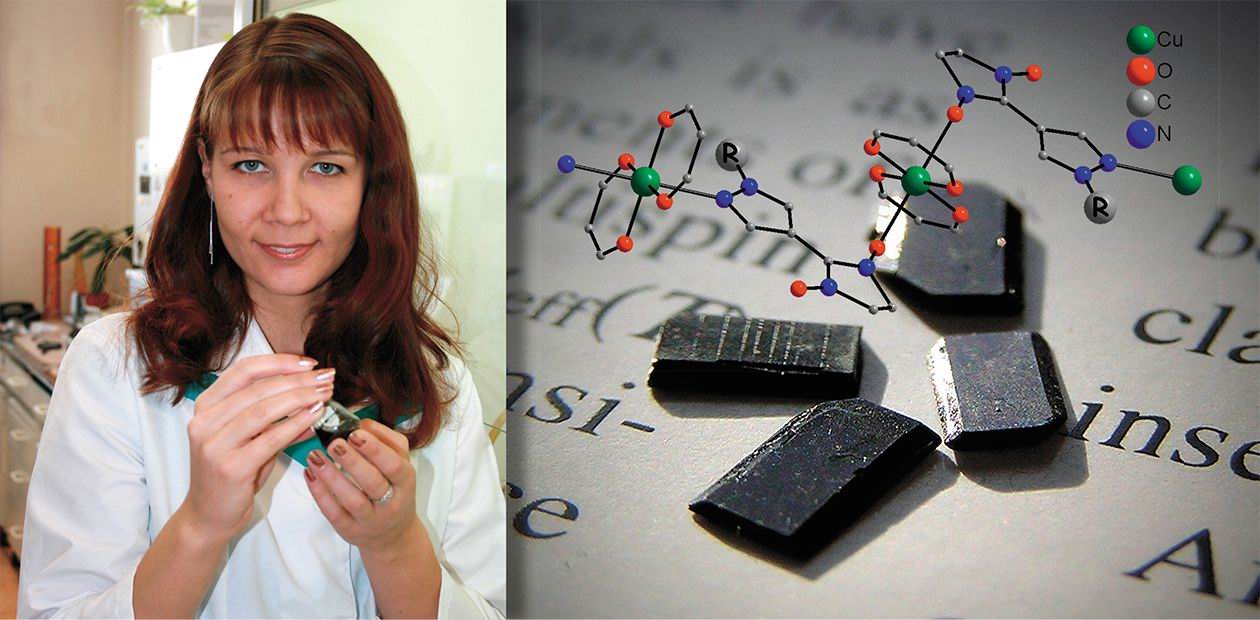"Breathing" Crystals
Candidate of Chemistry K. Yu. Maryunina became one of the winners of the 2009 competition for medals of the Russian Academy of Sciences with prizes for young scientists in the category General and Technical Chemistry. A prize for outstanding achievements in science was awarded to her for the series of studies of the unique magnetic and structural properties of heterospin "breathing" crystals. The results obtained by the young scientist open new opportunities for the molecular design of heterospin systems and for using chemical methods that can affect the character and temperature of magnetic anomalies.
The systematic investigation of different modifications of heterospin systems allowed us to develop a rather large class of "breathing" crystals with temperatures of magnetic-structural anomaly between 50 and 250 K. It gave us a more detailed understanding of mutually correlated movements of the atoms in a single crystal, movements that are coupled with magnetic phase transformations
Candidate of Chemistry K. Yu. Maryunina became one of the winners of the 2009 competition for medals of the Russian Academy of Sciences with prizes for young scientists in the category General and Technical Chemistry. A prize for outstanding achievements in science was awarded to her for the series of studies of the unique magnetic and structural properties of heterospin “breathing” crystals. The results obtained by the young scientist open new opportunities for the molecular design of heterospin systems and for using chemical methods that can affect the character and temperature of magnetic anomalies. Besides, they provide a deeper understanding of the reasons leading to these processes
The achievements of modern science make it possible to assemble individual molecules into compounds which possess new functional properties, not typical for the initial components.
The design of heterospin complexes is one of the areas of chemistry that develops most rapidly. The formation of new magnetically active materials begins with developing a unique organic compound that has an unpaired electron (spin label) in each molecule. Then, the chemical binding of organic spin-labeled molecules with other types of electron carriers, metal ions, leads to the formation of heterospin complexes, where several types of paramagnetic centers of different origin coexist simultaneously.
The number of new heterospin complexes with stable radicals grows continuously; their unusual chemical properties are being discovered; and new classes of materials that have no prior analogs appear.
The recently found “breathing” crystals have become one of such unpredictable discoveries; they have attracted the attention of both specialists in the constructing of magnetically active materials and of researchers working in related areas of science.
Magnetic breathing of a crystal
The investigation of heterospin compounds showed that in the case of temperature variation the complexes of copper(II) with pyrazolyl-substituted nitroxide radicals undergo phase transformations accompanied by unusual changes of their magnetic properties. Rather fragile crystals of these complexes demonstrate anomalous stability: they are not destroyed by the considerable changes of their volume and linear dimensions (as large as 12 %!) that occur during multiple phase transformations caused by their heating and cooling.
To understand the unusual behavior of the crystals, it is sufficient to imagine that you compressed a 10-cm pencil to 9 cm, and it did not break. Such crystals were called “breathing” crystals due to the fact that they resemble the expansion and compression of the chest when you breathe.
Owing to the unique ability of such crystals to “breathe,” their molecular structure was studied in different phase states (before and after phase transformations) in the temperature range of 30—300 K, and the observed anomalies were explained. The structural transformation of these heterospin complexes appears to be caused by substantial changes of distances between copper ions and nitroxide radicals (when most materials surrounding us are cooled or heated, these changes are smaller by at least one order of magnitude). The value and/or sign of the exchange interaction between the unpaired electrons of paramagnetic centers experience simultaneous abrupt changes, as indicated by the characteristic behavior of the dependence of the effective magnetic moment at temperatures close to phase transformation points.
It is the considerable change of interaction energy in the metal-nitroxide exchange cluster in the case of temperature variation that is the main point of this unusual phenomenon. Previously it has been assumed that the value of the exchange interaction in metal-nitroxide heterospin systems did not depend on temperature.
Our studies have shown that there are systems where the energetic barrier between different positions of unpaired electron carriers is so low that a minor change of temperature can cause a substantial change of the exchange interaction magnitude and sign.
Special attention in the studies is devoted to the new opportunities for the molecular design of heterospin systems and for the search of chemical methods that can affect the character and temperature of the observed anomalies.
The discovered ability of “breathing” crystals to form solid solutions containing different metals and/or ligands appears to be an efficient approach to affect their magnetic properties. This fact allowed us to expand the family of these unique objects due to a smooth regulation of the magnetic anomaly parameters by varying the composition of “mixed” compounds.
Another interesting method of modifying magnetic properties was found while we were investigating the effect of solvate molecules on the structural characteristics of solid phases. The increase of the solvent molecule size by one methylene (-CH2-) group only, when hexane is replaced by heptane, appears to have a dramatic effect on the magnetic properties of the compound.
An illustrative example of high sensitivity of such compounds to transformations is the observed change of the heterospin chain structure and, as a consequence, of the temperature of the magnetic anomaly as a result of isotope substitution in the paramagnetic ligand. For instance, the replacement of as few as three hydrogen atoms by deuterium atoms in one of radical substituents leads to the increase of the phase transition temperature by three degrees. The effect may be small, but its existence can be reproduced and registered.
The systematic investigation of different modifications of heterospin systems allowed us to develop a rather large class of “breathing” crystals with temperatures of magnetic-structural anomaly between 50 and 250 K. It gave us a more detailed understanding of mutually correlated movements of the atoms in a single crystal, movements that are coupled with magnetic phase transformations.
It should be noted that substantial progress in the investigation of “breathing” crystals was largely achieved due to cooperation with leading specialists in the fields of magnetic chemistry, x-ray structural analysis, quantum chemical calculations and electron paramagnetic resonance. Such cooperation is greatly facilitated by the integrated scientific environment of Akademgorodok in Novosibirsk.
As it often happens when a new field of science is being investigated, every new stage brings new interesting data in the behavior of the objects studied, as well as new questions requiring answers. As it was found relatively recently, phase transformations in “breathing” crystals can be initiated not only thermally but also by illumination …
References
Fedin M., Ovcharenko V., Sagdeev R., et al. “Light-Induced Exited Spin State Trapping in an Exchange-Coupled Nitroxide-Copper(II)-Nitroxide Cluster” // Angew. Chem. Int. Ed. 2008. V. 47. P. 6897—6899.
Maryunina K., Fokin S., Ovcharenko V., et al. “Solid solution: an efficient way to control the temperature of spin transition in heterospin crystals MxCu1-x(hfac)2L (M = Mn, Co, Ni; L = nitronyl nitroxide)” // Polyhedron. 2005. V. 24. P. 2094 —2101.
Ovcharenko V. I., Fokin S. V., Romanenko G. V., et al. “Nonclassical spin transitions”//Russ. J. Struct. Chem. 2002. V. 43. P. 153—169.
Ovcharenko V. I., Maryunina K. Yu., Fokin S. V., et al. “Spin transitions in non-classical systems” // Russ. Chem. Bull. (Engl. transl.) 2004. V. 53. P. 2406—2427.
Ovcharenko V., Romanenko G., Maryunina K., et al. “Thermally Induced Magnetic Anomalies in Solvates of
Bis(hexafluoroacetylacetonate)copper(II) Complex with Pyrazolyl-Substituted Nitronyl Nitroxide”// Inorg. Chem. 2008. V. 47. P. 537—9552.
Candidate of Chemistry K. Yu. Maryunina (International Tomographic Center SB RAS, Novosibirsk)





